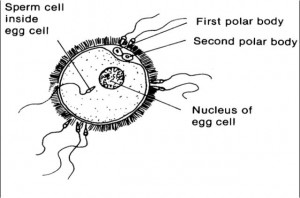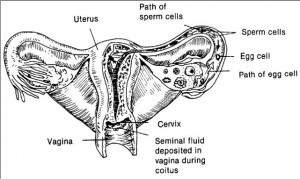a. Fertilization refers to the joining together of the ovum (egg) and sperm cells.
The ovum originates in the graafian follicle within the ovary. The sperm cell originates in the testes. The microscopic union of sperm and ovum increase in size more than 20 billion times from conception to birth. See figure 2-2 for union of sperm and ovum.
b. During sexual intercourse, 2 to 5 ml of semen, usually containing more than 300 million sperm, is ejaculated into the female’s vagina. By flagellar (wiggly) movement, the sperm make their way through the fluids of the cervical mucous, across the endometrium, and into the fallopian tube to meet the descending ovum in the ampulla of the fallopian tube (see figure 2-3). Only one sperm is required for actual fertilization, but the presence of many increases the chances for one to penetrate. The union between ovum and sperm occurs in the outer third of the fallopian tube.

c. The combined ovum and sperm, referred to as the zygote, begins rapid cell division and in 2 to 3 days becomes a structure referred to as morula. The morula is a rapidly growing structure and reaches the uterus in approximately 4 days.

